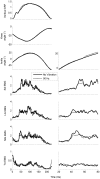Triceps surae short latency stretch reflexes contribute to ankle stiffness regulation during human running
- PMID: 21887345
- PMCID: PMC3161790
- DOI: 10.1371/journal.pone.0023917
Triceps surae short latency stretch reflexes contribute to ankle stiffness regulation during human running
Abstract
During human running, short latency stretch reflexes (SLRs) are elicited in the triceps surae muscles, but the function of these responses is still a matter of controversy. As the SLR is primarily mediated by Ia afferent nerve fibres, various methods have been used to examine SLR function by selectively blocking the Ia pathway in seated, standing and walking paradigms, but stretch reflex function has not been examined in detail during running. The purpose of this study was to examine triceps surae SLR function at different running speeds using Achilles tendon vibration to modify SLR size. Ten healthy participants ran on an instrumented treadmill at speeds between 7 and 15 km/h under 2 Achilles tendon vibration conditions: no vibration and 90 Hz vibration. Surface EMG from the triceps surae and tibialis anterior muscles, and 3D lower limb kinematics and ground reaction forces were simultaneously collected. In response to vibration, the SLR was depressed in the triceps surae muscles at all speeds. This coincided with short-lasting yielding at the ankle joint at speeds between 7 and 12 km/h, suggesting that the SLR contributes to muscle stiffness regulation by minimising ankle yielding during the early contact phase of running. Furthermore, at the fastest speed of 15 km/h, the SLR was still depressed by vibration in all muscles but yielding was no longer evident. This finding suggests that the SLR has greater functional importance at slow to intermediate running speeds than at faster speeds.
Conflict of interest statement
Figures


Similar articles
-
Triceps surae stretch reflex modulation after a mechanically evoked ankle dorsiflexion during the swing phase of human running.Motor Control. 2014 Oct;18(4):383-94. doi: 10.1123/mc.2013-0039. Epub 2014 Apr 9. Motor Control. 2014. PMID: 24718966
-
Stretch reflexes of triceps surae in normal man.J Neurol Neurosurg Psychiatry. 1982 Jun;45(6):513-25. doi: 10.1136/jnnp.45.6.513. J Neurol Neurosurg Psychiatry. 1982. PMID: 7119814 Free PMC article.
-
Effects of leg muscle tendon vibration on group Ia and group II reflex responses to stance perturbation in humans.J Physiol. 2003 Jul 15;550(Pt 2):617-30. doi: 10.1113/jphysiol.2003.043331. Epub 2003 May 30. J Physiol. 2003. PMID: 12777449 Free PMC article. Clinical Trial.
-
Triceps surae fascicle stretch is poorly correlated with short latency stretch reflex size.Muscle Nerve. 2015 Aug;52(2):245-51. doi: 10.1002/mus.24538. Epub 2015 Jun 3. Muscle Nerve. 2015. PMID: 25487638 Clinical Trial.
-
Contributions to the understanding of gait control.Dan Med J. 2014 Apr;61(4):B4823. Dan Med J. 2014. PMID: 24814597 Review.
Cited by
-
Reduced effects of tendon vibration with increased task demand during active, cyclical ankle movements.Exp Brain Res. 2014 Jan;232(1):283-92. doi: 10.1007/s00221-013-3739-2. Epub 2013 Oct 18. Exp Brain Res. 2014. PMID: 24136344 Free PMC article.
-
The effects of uniquely-processed titanium on biological systems: implications for human health and performance.J Funct Biomater. 2014 Jan 3;5(1):1-14. doi: 10.3390/jfb5010001. J Funct Biomater. 2014. PMID: 24956353 Free PMC article.
-
Effect of microtitanium impregnated tape on the recovery of triceps surae musculotendinous function following strenuous running.Springerplus. 2013 Dec 5;2:653. doi: 10.1186/2193-1801-2-653. eCollection 2013. Springerplus. 2013. PMID: 24349956 Free PMC article.
-
Patterns of intermuscular inhibitory force feedback across cat hindlimbs suggest a flexible system for regulating whole limb mechanics.J Neurophysiol. 2018 Feb 1;119(2):668-678. doi: 10.1152/jn.00617.2017. Epub 2017 Nov 15. J Neurophysiol. 2018. PMID: 29142095 Free PMC article.
-
Heksor: the central nervous system substrate of an adaptive behaviour.J Physiol. 2022 Aug;600(15):3423-3452. doi: 10.1113/JP283291. Epub 2022 Jul 19. J Physiol. 2022. PMID: 35771667 Free PMC article.
References
-
- Dietz V, Schmidtbleicher D, Noth J. Neuronal mechanisms of human locomotion. J Neurophysiol. 1979;42:1212–1222. - PubMed
-
- Ishikawa M, Komi PV. The role of the stretch reflex in the gastrocnemius muscle during human locomotion at various speeds. J Appl Physiol. 2007;103:1030–1036. - PubMed
-
- Dietz V. Analysis of the electrical muscle activity during maximal contraction and the influence of ischaemia. J Neurol Sci. 1978;37:187–197. - PubMed
Publication types
MeSH terms
LinkOut - more resources
Full Text Sources
Research Materials
Miscellaneous

